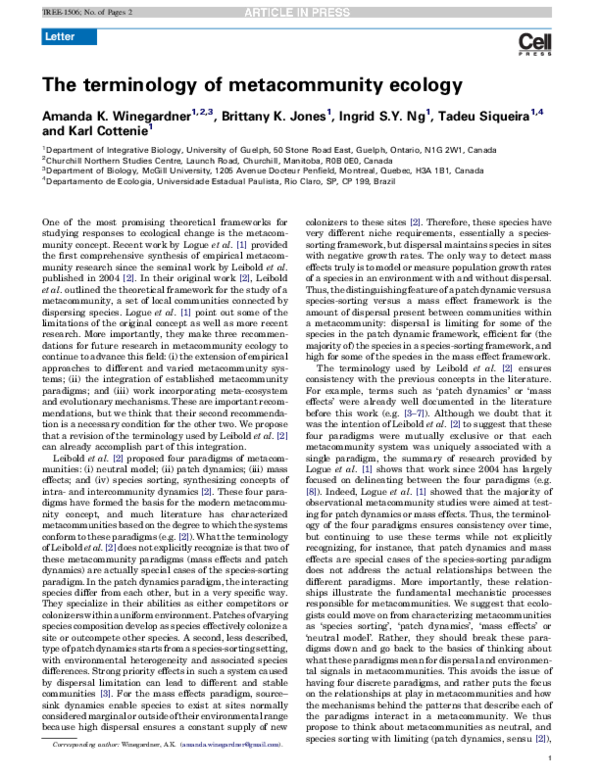Academia.edu no longer supports Internet Explorer.
To browse Academia.edu and the wider internet faster and more securely, please take a few seconds to upgrade your browser.
The terminology of metacommunity ecology
Related Papers
abstract: Adaptive evolution within species and community assembly involving multiple species are both affected by dispersal and spatiotemporal environmental variation and may thus interact with each other. We examined this interaction in a simple three-patch metacommunity and found that these two processes produce very different associations between species composition and local environment. In most conditions, we find a pattern we call " species sorting, " wherein local adaptation by resident species cannot prevent invasions by other preadapted species as environmental conditions change (strong association between local environmental conditions and local community composition). When dispersal rates are very low relative to the other two rates, local adaptation by resident species predominates, leading to strong priority effects that prevent successful colonization by other species that would have been well adapted, a pattern we call " local monopolization. " When dispersal and evolutionary rates are both very high, we find that an evolving species outcompetes other species in all patches, a pattern we call " global monopolization. " When environmental oscillations are very frequent, local monopolization predominates. Our findings indicate that there can be strong modification of community assembly by local adaptive processes and that these depend strongly on the relative rates of evolution, dispersal, and environmental change.
2008 •
Research on the interactions between evolutionary and ecological dynamics has largely focused on local spatial scales and on relatively simple ecological communities. However, recent work demonstrates that dispersal can drastically alter the interplay between ecological and evolutionary dynamics, often in unexpected ways. We argue that a dispersal-centered synthesis of metacommunity ecology and evolution is necessary to make further progress in this important area of research.
Mathematical Biosciences
Coexistence in metacommunities: A tree-species model2009 •
Abstract: Metapopulation theory has emerged as a popular paradigm for studying the abundance and distribution of species in a fragmented landscape. A recent extension to metapopulation theory has been the development of metacommunity theory, which broadens the framework to incorporate the interacting dynamics of multiple species. Much of the work using a metacommunity framework has focused on determining the necessary conditions for species coexistence. Another fundamental but neglected question is the ...
2004 •
Abstract The metacommunity concept is an important way to think about linkages between different spatial scales in ecology. Here we review current understanding about this concept. We first investigate issues related to its definition as a set of local communities that are linked by dispersal of multiple potentially interacting species.
Frontiers in Ecology and Evolution
Heterogeneity in the isolation of patches may be essential for the action of metacommunity mechanisms2023 •
RELATED PAPERS
Textura Ulbra
Escolástica e História: discussões historiográficas2013 •
Strategic Management Journal
Strategic planning in a turbulent environment: evidence from the oil majors2003 •
BMC Family Practice
What makes up good consultations? A qualitative study of GPs’ discourses2013 •
Speaking the Truth in Love: The Theology of John M. Frame
Transcendental Argument Revisited2009 •
http://blogs.bbk.ac.uk/bbkcomments/2022/05/17/21-tips-on-how-to-become-a-successful-researcher/
Blog: Twenty-one tips on how to become a successful researcher2022 •
Medical and Veterinary Entomology
Seasonality of Old World screwworm myiasis in the Mesopotamia valley in Iraq2005 •
2011 •
Canto Rodado Revista Especializada En Patrimonio
Notas de un antropólogo de campo (1970-2013)2013 •
RELATED TOPICS
- Find new research papers in:
- Physics
- Chemistry
- Biology
- Health Sciences
- Ecology
- Earth Sciences
- Cognitive Science
- Mathematics
- Computer Science
